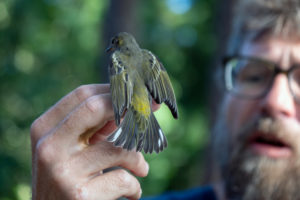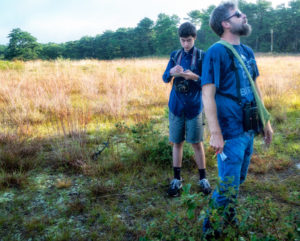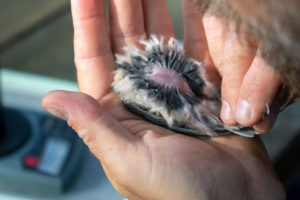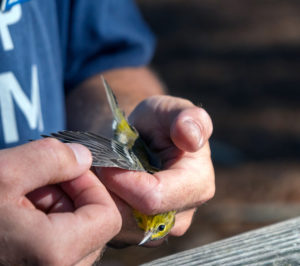
WELLFLEET — A Cape May warbler is flying through a pine forest. Its brown-green wings flutter madly as it races to keep up with its flock. It has been feeding all summer in Canada on an abundance of spruce budworms and has accumulated enough fat to make the journey south.
As it heads towards a small thicket, it flies headlong into a nearly invisible net. Falling down the smooth, soft surface of the net, it is caught in a mesh pocket and lies prone, unharmed, until a gentle hand reaches in to extract it.
Migratory and year-round birds are captured by this method at the Wellfleet Bay Wildlife Sanctuary so that they can be counted, studied, and banded. Not just anyone can do this work. In fact, it is illegal for an unlicensed person to handle a wild bird. At the Audubon sanctuary a federally licensed bird bander affixes a light metal ring with a number to each bird’s leg.
Bird-banding is used by Audubon primarily as a way to keep track of population sizes both locally and globally. Once a bird has been banded its migratory patterns and health status can be monitored through the work of bird-banding stations from Canada to South America.
Recent research has underlined the urgency of this work. The journal Science reported this month that the number of birds in the U.S. and Canada has dropped by 29 percent in the last 50 years. David Yarnold, president of the National Audubon Society, described these findings on the organization’s website as “a full-blown crisis.”
The bird banding data collected here are also used to improve the local habitat to benefit the birds that live in and pass through the sanctuary. Jenette Kerr, the publicity and media coordinator at Wellfleet Bay, explains, “The sanctuary actively works to keep two areas from becoming reforested — the sand plain grassland (where all the bird boxes and the osprey pole are) and a heathland along the Goose Pond Trail (most viewable from the back side of the trail). Prescribed burns are conducted at both sites.”

Currently, bird banders and bird-watchers alike are seeing early fall warblers migrating south. We have not been getting too many new arrivals, as the prevailing wind has been from the southwest — not helpful to the warblers, who use north winds to assist them as they migrate hundreds of miles south. The New York Times reported that the recent study of declining bird populations found warblers were among the hardest hit, “with a population that dropped by 617 million.”
As these birds pass over the Cape, many for the first time because they have only recently hatched, some get caught and banded at the Audubon sanctuary. These are small, flighty birds. To catch them, the sanctuary usually strings 23 large so-called mist nets in front of complicated backgrounds, such as bushes or trees, in the hope that the birds will not see them. Nets are placed on the edges of habitats, as that is where most nonbreeding birds live. (At this time of year most species are not breeding.)
Each net has four pockets into which the birds fall. Every 40 minutes, Audubon ornithologist James Junda or a volunteer like Frank Mockler checks the nets and takes down any birds in them, transfering them to a clean white cloth bag. This isolates the bird as not to cause it undue stress. Junda continues to check the remaining nets, so no bird stays in them too long. After checking all the nets Junda takes the birds back to a picnic table to study them.
On a recent Sunday Junda had a line of bags hung on a tree. He took one, reached inside, and pulled out a Cape May warbler. Holding the bird in a bander’s grip to keep it safe and relaxed, his hand around its body and its head between his pointer and middle fingers, he determined the sex and species of the bird and its approximate age by checking wing feather coloration.

Then he turned it upside down. Blowing on its breast to part the small feathers that lie there, Junda assessed the amount of fat stored in the divot in the bird’s neck, called the furcular hollow, and how much muscle it had. Having been a bander for so long, Junda can tell almost immediately how much fat a bird has and whether that is normal, given the bird species and time of year.

A bird’s fat level is a good indicator of whether it is migrating; migrating birds have large fat reserves. The amount of muscle is an indicator of overall health.
Junda then took a pair of pliers specially made for banding, with two different-sized circular holes for crimping the bands shut and two little prongs for opening them. He selected a unique metal band of the correct size, told Mockler, his volunteer assistant, the band number to enter on a datasheet, and opened the band. He put the band into the pliers, slipped it over the bird’s leg, and bent it shut.
The bands, when applied correctly, are loose enough to spin freely and just tight enough not to slip off. They do not hinder the birds in any way.

For the most part, the birds hold still while this goes on and don’t make a sound. Tag numbers and bird information are later entered in an international database so that they can be used by other nature sanctuaries and conservation programs. What the data reveal informs efforts to protect bird populations.
The Wellfleet Bay Wildlife Sanctuary is continuing its bird banding and research education programs this season until Nov. 9. Information on how to join a morning bird banding group to learn about this conservation technique is at massaudubon.org/get-outdoors/wildlife-sanctuaries/wellfleet-bay/.



